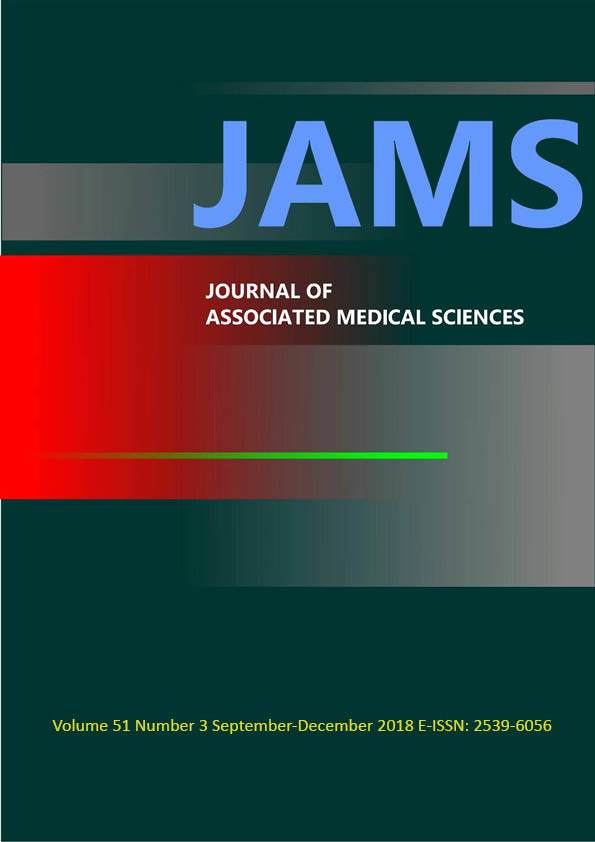Quantification of hepatitis B virus (HBV) DNA and HBV genotyping simultaneously in plasma using real-time polymerase chain reaction
Main Article Content
Abstract
Background: in Thailand, an estimated three million people are chronically infected with hepatitis B virus (HBV), mostly with genotypes C and B. Level of HBV replication as measured by quantification of HBV DNA in blood is crucial for management of chronic hepatitis B. However, HBV DNA measurement is not widely used due to limited availability and high cost of the test.
Objectives: To establish an assay for both HBV DNA load and HBV genotyping based on Fluorescence Resonance Energy Transfer (FRET) real-time polymerase chain reaction (PCR) technique and evaluate it using clinical samples.
Materials and methods: Published primers and FRET probes were used. Whole genome clones of HBV genotype B and C were used as reference. HBV DNA was extracted from clinical samples using a commercial platform (Abbott m2000sp system) and was then measured with the LightCyclerâ (Roche Diagnostics Applied Science). Results obtained with the in-house assay were compared to those obtained with COBASâ TaqManâ HBV Test, v2.0 (reference).
Results: We established an in-house assay with a sensitivity of 100 IU/mL of HBV DNA. Measurement of HBV DNA in 36 clinical samples showed a very good correlation between HBV DNA load measured with in-house real-time PCR assay (R = 0.946), compared to the reference assay. This assay identified HBV genotype B and genotype C based on the melting temperature peaks, 61-64oC and 52-56oC, respectively, and identified the presence of mixed HBV B and C genotypes if the minor population represents 10% or more of the whole population. HBV genotyping was possible in 22 of 28 samples with HBV DNA load above 2.00 log10 IU/mL: 4 (18%) were genotype B and 18 (82%) were genotype C.
Conclusion: This in-house real-time PCR assay showed good performance for HBV DNA quantification in clinical samples and could distinguish B or C genotypes. It can represent an alternative to commercial assays for clinical use.
Article Details

This work is licensed under a Creative Commons Attribution-NonCommercial-NoDerivatives 4.0 International License.
Personal views expressed by the contributors in their articles are not necessarily those of the Journal of Associated Medical Sciences, Faculty of Associated Medical Sciences, Chiang Mai University.
References
[2] Ganem D, Prince AM. Hepatitis B virus infection--natural history and clinical consequences. The New England journal of medicine. 2004; 350(11): 1118-29.
[3] World Health Organization (WHO). Guidelines for the prevention, care and treatment of persons with chronic hepatitis B infection2015.
[4] Suwannakarn K, Tangkijvanich P, Thawornsuk N, Theamboonlers A, Tharmaphornpilas P, Yoocharoen P, et al. Molecular epidemiological study of hepatitis B virus in Thailand based on the analysis of pre-S and S genes. Hepatol Res. 2008; 38(3): 244-51.
[5] Tangkijvanich P, Mahachai V, Komolmit P, Fongsarun J, Theamboonlers A, Poovorawan Y. Clinical and virological differences between hepatitis B virus genotypes B and C: a case-control study. Journal of the Medical Association of Thailand = Chotmaihet thangphaet. 2004; 87 Suppl 2: S223-7.
[6] Duong TN, Horiike N, Michitaka K, Yan C, Mizokami M, Tanaka Y, et al. Comparison of genotypes C and D of the hepatitis B virus in Japan: a clinical and molecular biological study. Journal of medical virology. 2004; 72(4): 551-7. doi: 10.1002/jmv.20044.
[7] Kao JH, Chen PJ, Lai MY, Chen DS. Hepatitis B genotypes correlate with clinical outcomes in patients with chronic hepatitis B. Gastroenterology. 2000; 118(3): 554-9.
[8] Kao JH, Wu NH, Chen PJ, Lai MY, Chen DS. Hepatitis B genotypes and the response to interferon therapy. J Hepatol. 2000; 33(6): 998-1002. doi: S0168-8278(00)80135-X.
[9] Leroi C, Adam P, Khamduang W, Kawilapat S, Ngo-Giang-Huong N, Ongwandee S, et al. Prevalence of chronic hepatitis B virus infection in Thailand: a systematic review and meta-analysis. Int J Infect Dis. 2016; 51: 36-43. doi: S1201-9712(16)31144-4 [pii]10.1016/j.ijid.2016.08.017.
[10] Thai Association for the Study of the Liver. Thailand practice guideline for management of chronic hepatitis B and C. 2015.
[11] Yeh SH, Tsai CY, Kao JH, Liu CJ, Kuo TJ, Lin MW, et al. Quantification and genotyping of hepatitis B virus in a single reaction by real-time PCR and melting curve analysis. J Hepatol. 2004; 41(4): 659-66. doi: S0168-8278(04)00300-9 [pii]10.1016/j.jhep.2004.06.031.
[12] Khamduang W, Gaudy-Graffin C, Ngo-Giang-Huong N, Jourdain G, Moreau A, Borkird T, et al. Analysis of residual perinatal transmission of hepatitis B virus (HBV) and of genetic variants in human immunodeficiency virus and HBV co-infected women and their offspring. J Clin Virol. 2013; 58(2): 415-21. doi: 10.1016/j.jcv.2013.06.025S1386-6532(13)00257-6.
[13] Naito H, Hayashi S, Abe K. Rapid and specific genotyping system for hepatitis B virus corresponding to six major genotypes by PCR using type-specific primers. Journal of clinical microbiology. 2001; 39(1): 362-4. doi: 10.1128/JCM.39.1.362-364.2001.


